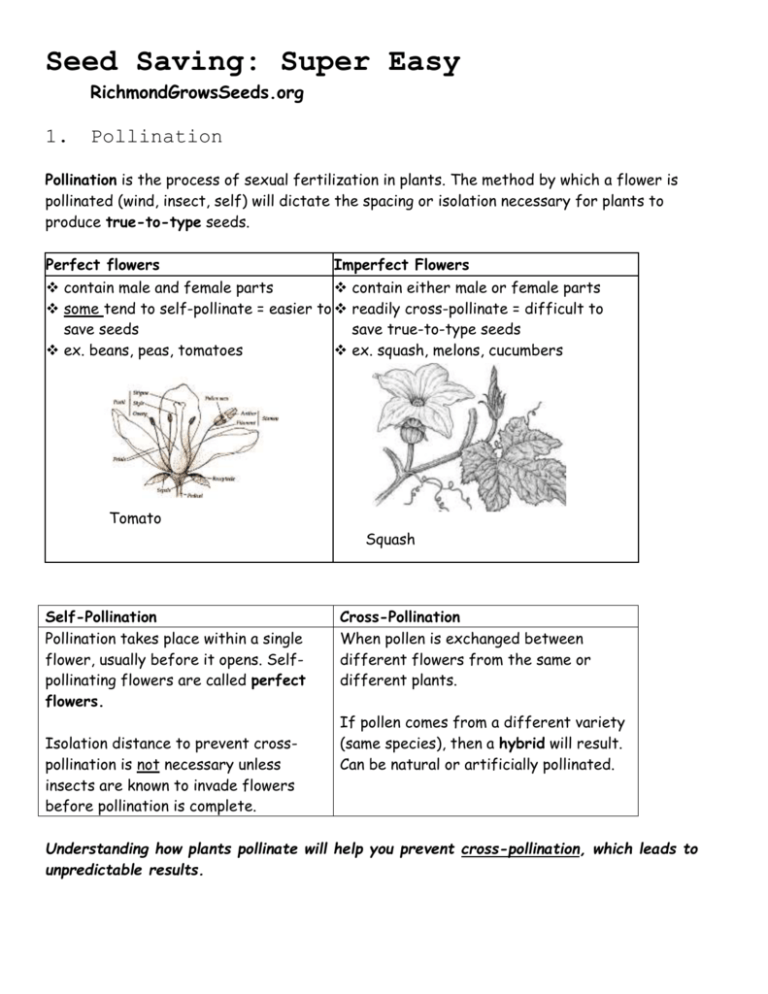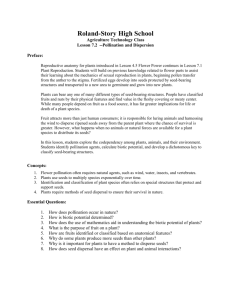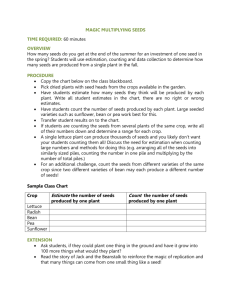class handout - Richmond Grows Seed Lending Library
advertisement

Seed Saving: Super Easy RichmondGrowsSeeds.org 1. Pollination Pollination is the process of sexual fertilization in plants. The method by which a flower is pollinated (wind, insect, self) will dictate the spacing or isolation necessary for plants to produce true-to-type seeds. Perfect flowers Imperfect Flowers contain male and female parts contain either male or female parts some tend to self-pollinate = easier to readily cross-pollinate = difficult to save seeds save true-to-type seeds ex. beans, peas, tomatoes ex. squash, melons, cucumbers Tomato Self-Pollination Pollination takes place within a single flower, usually before it opens. Selfpollinating flowers are called perfect flowers. Isolation distance to prevent crosspollination is not necessary unless insects are known to invade flowers before pollination is complete. Squash Cross-Pollination When pollen is exchanged between different flowers from the same or different plants. If pollen comes from a different variety (same species), then a hybrid will result. Can be natural or artificially pollinated. Understanding how plants pollinate will help you prevent cross-pollination, which leads to unpredictable results. 2. Heirlooms and Hybrids Open-pollinated produce plants identical to parents not hybrid open-pollinated seeds that have special significance to a family/community are often referred to as heirloom varieties all individuals within a population are allowed to inter-mate via wind or insects Hybrid a cross between two genetically distinct parent plants; these distinct parent populations are each known as an “inbred line” also called Filial 1, F1, or F – these are the first progeny of the inbred lines First generation (F1) plants usually show more “vigor” than either parent Second generation (F2) plants will not be uniform Don’t save seeds from hybrids for the library Heirlooms = plants that have “a face, a place and a story” 3. Biology 101 Plants in the same family have similar characteristics, such as flower and leaf structure, and are often saved in similar ways. Family Genus (plural Genera) Species Variety Cultivar The scientific/botanical name is written in italics with the genus capitalized. Ex. Carrot Apiaceae - Daucus carota var. sativus ‘Scarlet Nantes’ Family: Apiaceae Genus: Daucus Species: carota Variety: sativus Cultivar: Scarlet Nantes Note: Botanical name = Genus + species: Daucus carota 4. Seed Saving General Guidelines 1. 2. 3. 4. Keep good garden records or put out a label with the variety, source and year of seeds. Always choose from the healthiest plants that are true-to-type. Remove plants that are not true-to-type plants (rouging) or tag the plants you intend to save from. Remove plants you don’t intend to save seeds from before they flower. Plan your garden to reduce cross-pollination: a. plant one variety per species, or only allow one variety to go to seed b. separate varieties by planting something tall in between (ex. corn or sunflowers) or plant on different sides of your house c. have a friend plant another variety and share produce d. stagger the planting of two varieties within a species so that pollination time does not overlap; pollination occurs during flowering so note when flowers of different varieties are open Keep up with the Joneses. Know what varieties your neighbors are planting. Never plant all of your seeds in one year. 5. 6. Selection Traits Vigor Taste Ability to tolerate drought, wind or other extreme conditions Ability to compete with weeds Early- or late-bearing fruit (whichever is desired) Long storage life Late to go to seed or bolt Good fruit texture Disease resistant Productivity Cold hardiness Resistance to insect pests Larger fruit or flowers Attractiveness Color Shape Envelope Recommendation: What to Write on Your Seed Envelopes time to germination and time to maturity planting instructions include why you saved seeds from a particular plant (See Selection Trait List) Remember that when you return seeds the next person has to rely on your notes on the envelope. Sunflower Family Scientific family name: Asteraceae or Compositae Common family name: Aster, Daisy, or Sunflower Common family members: Artichoke, cardoon, endive, Jerusalem artichoke, lettuce, salsify, shungiku, sunflower. Type of flower: Perfect Type of pollination: Self or insects Population size (lettuce): 10-20 Harvesting: Let the seeds dry on the plant. Collect. Envelope tips: Lettuce: color, slow bolting, suitable for winter, type of leaf: looseleaf, crisphead, romaine (cos), butterhead Sunflower: flower color, size of seed, size of plant, branching or central stem, size of head, taste of seeds Notes: For Jerusalem artichokes, the tuber is planted. For others in this family, allow the plants to flower, collect dry seeds. When half the lettuce flowers are fluffy white, you can cut off the stock and place it upside down in a paper bag in a dry place. Let them mature and dry in the bag then clean. Most sunflowers are partially self-incompatible, which means the flowers on one plant must be pollinated by pollen from flowers on another plant. Plant multiple plants of one variety to ensure best seed set. Cross-pollination in lettuce is very low. Multiple varieties can be grown in one garden. Bean and Pea Family Scientific family name: Fabaceae or Leguminosae Common name: Pea, Bean, Legume or Pulse Common family members: bean, lentil, pea, peanut, soybean Type of flower: Perfect Type of pollination: Self Population size: 10-20 plants Harvesting: Allow beans and peas to dry in their pods on plants before collecting and storing. Envelope tips: Peas: type (sugar snap, snow, green/shelling) Beans: bush (determinant) or pole (indeterminant), use (green, dried) Know your beans? If you know the scientific name of your bean, then you can plant one of each species and not have to worry about cross-pollination. Here are a few of the major species: Scientific name Common name Examples Phaseolus vulgaris Common bean Vicia faba Fava or broad bean Anasazi, black beans, borlotti types, pink beans, pinto, shell, white and yellow beans Negreta, Windsor, Tarma Phaseolus coccineus Runner beans Scarlet runner, sunset runner Phaseolus lunatus Lima or Butter beans Christmas, Henderson Notes: Beans and peas have a low cross-pollination rate. To reduce cross-pollination between different varieties of beans or peas isolate the plants by spacing them apart. Plant different pea varieties 50 ft apart and beans 100 ft apart. To eliminate cross-pollination, grow different species of beans. Ex. Runner beans (Phaseolus coccineus) will not cross with a common bean (Phaseolus vulgaris) such as Kentucky Wonder. Nightshade Family Scientific family name: Solanaceae Common family members: Cape gooseberry, eggplant, ground cherry, pepper, potato, tomatillo, tomato. Type of flower: Perfect Type of pollination: Self Population size: 10-20 plants; hot peppers & currant tomatoes 40 Harvesting: Allow fruits to fully ripen. Then seeds should be rinsed and pulp removed. Dry them thoroughly before being stored. For tomatoes squeeze seeds and some pulp into a jar. Letting tomato pulp ferment in water for a few days before cleaning kills harmful microorganisms Envelope tips: Tomatoes: determinant (bush)/indeterminant; color; use (paste, slicing); shape; size; disease-resistance; suitable for containers; good in cool; early, mid or late-season; length of harvest season Peppers: heat (sweet/hot), size, use (spice, drying, stuffing, frying) Eggplant: color, size, type (Asian, Italian) Notes: Potatoes are grown from tubers not seeds. Different varieties of peppers may cross if grown together. To avoid hot peppers from crossing with sweet, don’t plant them near each other Parsley Family Scientific family name: Umbelliferae or Apiaceae Common family members: Carrot, celery, caraway, chervil, cilantro (coriander), dill, fennel, parsley, parsnip Type of flower: Perfect Type of pollination: Insect Harvesting: Let the seeds dry on the plant. Collect. Population size: carrots/parsnips – 50 plants allowed to flower; keep flowering carrots 1 ft apart in rows 3 ft wide by 17 feet long – carrots can severely inbreed! Don’t save carrots unless you have the population minimum; celery, caraway, chervil, cilantro, dill, fennel, parsley – 25 plants Isolation distances: ¼ miles Inbreeding depression (=loss of vigor): carrots – severe; others in family exhibit moderate to limited Envelope tips: Carrots: color, size, shape, whether container appropriate Fennel: bulbing or foliage Parsley: curly, flat Notes: Many plants in this family are biennial, so flowering may not occur until the second year. Don’t save carrots if Queen Anne’s Lace is nearby. It will cross. Yucky and bitter! 5. Storage Store in a cool, dry location. Seeds can be kept in paper or glass. Do not store in plastic. Seed Limit: Temperature (oF) + relative humidity (%) less than 100 Refer to Seed Chart on website for viability.







